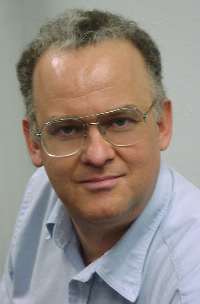Ralph Merkle
- Birthdate
- 1952/02/02
- Associated organizations
- University of California, Zyvex
- Fields of study
- Nanotechnology, Cryptography
Biography
Ralph Merkle is a computer scientist, researcher, and leading proponent of molecular manufacturing, one of the major theoretical approaches to nanotechnology. He is also well-known for his pioneering work in the field of cryptography. Merkle earned a B.A. in computer science from the University of California, Berkley, in 1974 and a Ph.D. in electrical engineering from Stanford in 1979. He has worked at Xerox’s Palo Alto Research Center and as a researcher and theorist at Zyvex, a nanotechnology start-up firm. He is currently Distinguished Professor of Computer Science at the Georgia Institute of Technology.
In 1974 Merkle first proposed what is now referred to as “public key” cryptography. This idea was the basis of the Diffie-Hellman key exchange proposed by Whitfield Diffie and Martin Hellman in 1976. Cryptography generally uses complicated mathematical algorithms to code data. For most encryption schemes, if someone knows how to code a message they also know, by definition, how to decode it. This means that the encryption algorithm must be kept secret, which limits its utility. Merkle realized, however, that it is possible to code and decode information using two different algorithms that are related to one another. If the second algorithm is highly difficult to perform—for example, because it is based on extremely large numbers that take a very long time to compute—then even the intended receiver will not be able to decode it due to the difficulty of performing the necessary computation. However, if the second algorithm is such that with an additional piece of information it becomes very easy to perform, then anyone can encode a message using the first, freely shared, algorithm, but only the person with the small bit of information that makes the second algorithm computable will be able to decode it. This allows for the easy encryption of data using public keys, while ensuring that only the intended receiver is able to decipher the information. Working with Martin Hellman, Merkle developed one of the earliest public key encryption systems based on this idea in 1978.
Merkle became interested in nanotechnology in the early 1980s while working at Xerox’s Palo Alto Research Center. Since then, he has become one of the foremost advocates of molecular manufacturing, the theoretical approach to nanotechnology pioneered by K. Eric Drexler. Following Drexler, Merkle argues that molecular-sized “assemblers” —tiny machines with actual gears and levers—will soon be able to physically arrange molecules in any way theoretically possible. Merkle has worked closely with Drexel to promote this theory to both the broader scientific community and to the public. He has served as vice-president of technology assessment at the Foresight Institute, a non-profit institution founded by Drexler in1986 to promote the field, has chaired both the Fourth and Fifth Foresight Conferences on Molecular Nanotechnology, and serves on the board of the Executive Editorial Board of the journal Nanotechnology. In 1995 a reporter described the pair as “being the inventors and most vociferous proponents of the theory,” as well as “the unofficial figureheads of the nanotechnology movement, coordinators of a loosely knit global network of scientists.”
For Merkle, as for Drexler, nanotechnology promises to fundamentally transform the world around us. “It will let us make supercomputers that fit on the head of a pin and fleets of medical nanorobots smaller than a human cell able to eliminate cancer, infections, clogged arteries, and even old age,” he writes. “People will look back on this era with the same feelings we have toward medieval times—when technology was primitive and almost everyone lived in poverty and died young.” However, most scientists are more cautious than Merkle in their assessment of nanotechnology’s potential. Most also reject the theory of molecular manufacturing in favor of other approaches, such as those favored by Richard Smalley. Furthermore, some scientists are wary of Merkle, Drexler, and the Foresight Institute because of their association with what are frequently considered fringe scientific projects. Merkle, for example, is very interested in cryonics, the science of freezing human bodies so that they may one day be brought back to life. Merkle serves on the board of directors of Alcor, a non-profit cryonics company, and he has arranged to have his own head frozen upon his death. He argues that future advances in nanotechnology will be able to repair damage to the body caused by freezing, and that as a result he will one day be brought back to life. Although such claims make many scientists wary, it cannot be disputed that Merkle’s breadth of vision has been an important driving force in the early history of nanotechnology.
